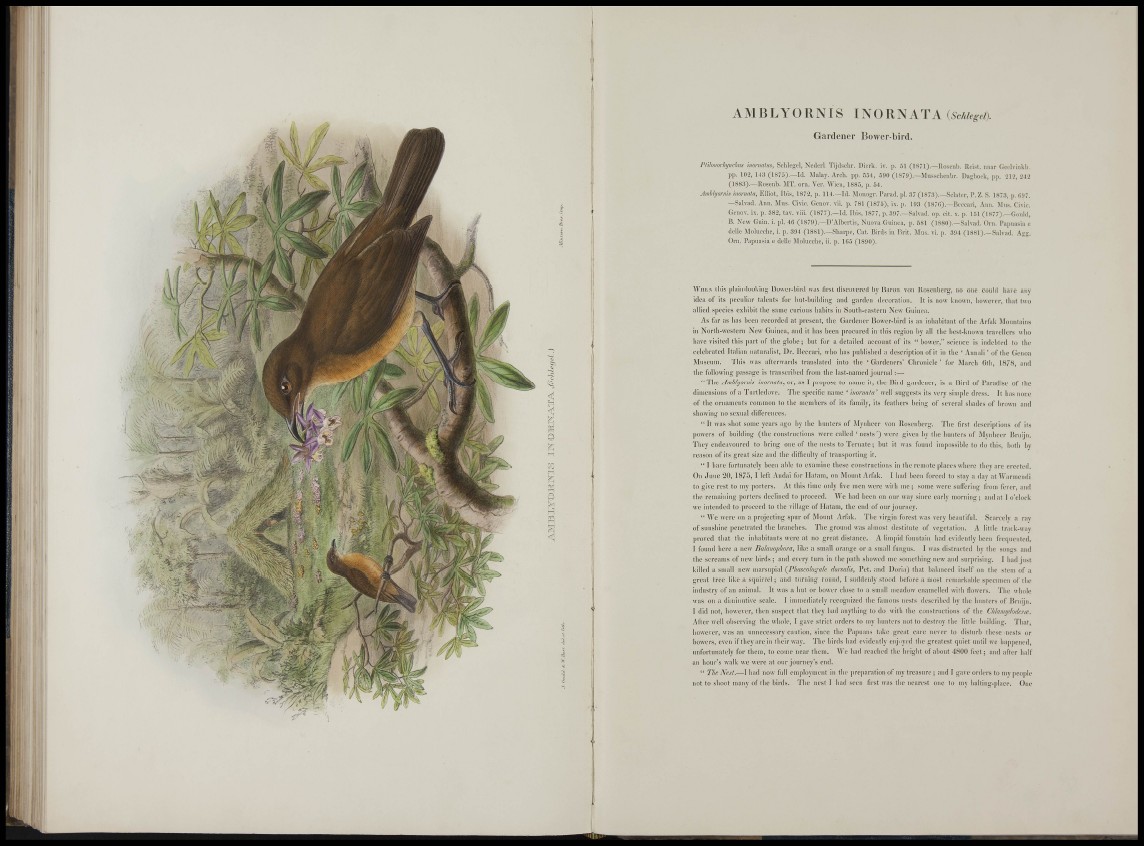
;
)
! i
: 4 K^íS'
i©
H
a
A M B L Y o R N I S IN O R N A T A i Schlegel).
Gardener Bower-bird.
Pliloiiorkjnckis iiwriwlus, Sdilegel, Neclerl Tijdschr. Dierk. iv. p. 51 (1871).—lioscnb. Rcist. naar dcclviiiklj.
pp. 102, 1 « (1S7.Í).—Id. llday. Arch. pp. 534, 6!)0 (1873).—Mussclicnlji-. Dagbock, pp. 21-2, 24-2
(1883).—Rosenb. MT. orri. Ver. Wion, 1885, p. 54.
Amhhjmús ¡nomata, Elliot, Ibis, 1872, p. 114.—Id. Moiiogr. Parad, pi. .'37 (187. ' i).—Sclatcr , P. Z. S. 1873, j), (107.
—Salvad. Anr. Mus. Civic. Geiiov. vii. p. 781 (1875), i.v. p. 1!)3 (1876).—Bcccari, Aim. Mus. Civic.
Genov. ix. p. 382, tav. viii. (1877).—Id. Ibis, 1877, p. 3a7.—Salvad, op. cit. x. p. 151 (1877).—Gould,
B. New Guin. i. pi. 40 (1870).—D'Albcrtis, Nuova Guinea, p. 581 (ISSO).—Salvad. Oni. I'apuasia e
delle Molucche, i. p. 304 (1881).—Sharpe, Cat. Birds in Hrit;. Mus. vi. p. 304 (1881).—Salvad. Agg.
Orn. Papuasia e delle Molucche, ii. p. 1()5 (1800).
WHEN this ¡¡liiin-looliiug Uoivcr-biril was first (liscovored Ijy Baroii voii lioscnhcrc;, no one coulil have any
i d e a of its peculiar talents for liut-bnilding and garden decoration. It is now known, liowever, that two
a l l i ed species exhibit the same curious habits in South-eastern New Guiiiea.
As far as has been recorded at ])resent, the Gardener Bower-bird is an inhabitant of the Arfak Mountains
in North-western New Guinea, and it has been procured in this region by all the best-known travellers who
have visited this part of tlie globe ; but for a detailed account of its " bower," .science is indebted to the
c e l e l ) r a t e d Italian naturalist. Dr . Beccari, who has published a descri|)tion of if in the ' Aniiali ' of the (ienoa
Museum. This was afterwards translated into the 'Gardeners' Chronicle' for March (itli, 1878, and
t h e following passage is transcribed from the last-named jourmd :—
" T h e Amhhjorms inornain, or, as I propose to tianie if, the Bird gardener, is a Bird of Paradise of the
d i m e n s i o n s of a Tnrtledo\'e. The sj)ecific name * tnornnia^ well suggests its vei'y simple dress. It lias noi;e
of the ornaments common to the members of its family, its feathers being of several shades of brown and
s h o w i n g no sexual diirerenccs.
" It was shot some years ago by the limiters of Mynheer voti Rosenberg. The first descriptions of its
jiowers of building (the constructions were called 'nests' ) were given by the himters of Myidicer liriiijn.
T l i e y endeavoured to bring one of the nests to T e r n a t e ; but it was found imj)nssible to do this, bntli by
reason of its great size and the difficulty of transporting if.
" ] have fortUTiately ijccn ai)le to examine these constructions in llie remot e places wher e tliey are erected.
On June 20, 187.J, I left Andai for I latam, on .Momit Ar fak. I bad been forced to stay a day at Warnienili
to give rest to my porters. At this time only five men were with me; some were snffering from fever, and
t h e renuiining porters declined to proceed. We had been on oin- way since early morning; and at I o'clock
wo inteiuled to ])roceed to the village of Hatam, the end of our journey.
" We were on a |irojecting spur of Mount Arfak. The virgin forest was very beautiful. Scarcely a ray
of sunshine ])enetrated the branches. The ground was almost dcstilute of vegetation. A little track-way
proved that the inhabitants were at no great distance. A limpid foinitaiu had evitlenfly been fretpiented.
I foinid here a new Balaimphora, like a small oratige or a small fungus. I was disti"acted by fbe songs and
t h e screams of new birds ; and every turn in the pat h showed me something new and surjirising. I had just
killed a small new ntarsupial {I'liasmlogale (lormlis, Pet. and Doria) that balanced itself on the stem of a
g r e a t tree like a squirrel ; and turning round, I sinldenly stood before a most remarkable specimen of the
i n d u s t r y of an animal. It was a hut or bower close to a small meadow enamelled with (lowers. The whole
was on a diminutive scale. 1 immediatel y recognized the famous nests described by the hunters of Bruijri.
I did not, however, then suspect that they bad anything to do with the constructions of the Chlnmifladera!.
A f t e r well obser\ iug the whole, I gave strict orders to my hunters not to destroy the littbi building. That,
however, was an unnecessary caution, since the Papuans take great care never to disturb these nests or
bowers, even if they are in their way. The birds bad evidently enjiiyed the greatest quiet until we happened,
u n f o r t u n a t e l y for them, to come near them. AVe bad reached the height of about 4800 feet ; and after half
an hour's walk we were at our journey' s end.
" The Nest.—I had now full employment in the preparation of my treasure ; and I gave orders to my people
not to shoot niariy of the birds. The nest I had seen first was the nearest one to my halting-place. One
i l l '
J.b
I'ii